By Sara R. Abelson, Janelle R. Goodwill, and Meghan A. Duffy
This piece was commissioned by The Steve Fund, which works nationally to support the mental health and emotional well-being for students of color.
College students are struggling more with their mental health than ever before: the percentage of students who reported being diagnosed with a mental health condition increased by 13.6 percent between 2007 and 2017 (from 21.9 percent to 35.5 percent), and the number who reported suicidal ideation in the past year increased by 5 percent. The COVID-19 pandemic now poses additional unprecedented stressors, isolation, and disruption. Elevated levels of adverse mental health conditions, substance use, and suicidal ideation were reported by adults in the United States in June 2020, with highest levels among those ages 18–24.
Many colleges and universities have responded to growing student mental health concerns by appointing a task force to identify areas of need and opportunities for change. Task forces can aid in coordinating efforts across campus and can also be used to redress systemic factors that impede student mental health and well-being.
Given the persistence of significant mental health inequities—disparate mental health stressors, symptoms, access to care, and consequences from mental health struggles—centering equity is essential for mental health task forces to succeed. Without attention to equity, specific student populations will be left behind. Prior research, including by the Healthy Minds Network team, demonstrates that students of color, LGBTQ+ students, first–generation students, students facing basic needs insecurities, and international students experience greater mental health burdens and more barriers to care.
Through our research and experiences with the University of Michigan’s Rackham Graduate School Task Force on Graduate Student Mental Health, we identified eight ways that university mental health task forces can center equity in their work.
1. Invest for impact and action. To be successful, task forces must be designed, structured, and supported to achieve substantive change. Task forces convened for optics and not equipped for success are not only a missed opportunity, but cause harm. The University of Michigan set its task force up for success by:
- Compensating task force members for their time and effort (this is essential for building a task force that has a diverse membership).
- Defining a scope that was ambitious but achievable. Given the size of Michigan, our task force focused on PhD student mental health to be effective.
- Planning for a two-year effort in which the task force was expected to not only identify recommended changes but enact those changes.
- Having the task force chair report to and regularly meet with someone in a leadership position (an associate dean in Rackham Graduate School, in our case).
- Providing paid staff support for the task force’s work.
- Establishing a process early on for how the task force’s recommendations would be reviewed and implemented.
- Continuing efforts outside the task force. The task force was not Michigan’s sole response to graduate student mental health, and the work of the task force was complemented by other efforts on campus.
2. Consider the task force composition.
- Do the demographics of your task force reflect the diversity[1] of your student body?
- Does the task force include people with expertise in diversity, equity, and inclusion (ideally in higher education)?
- Does it include anyone with expertise in disability studies?
- Do the members span the breadth of disciplines at your institution?
- Does it include a mixture of graduate students, faculty, mental health professionals, and university staff?
- Is there an undue service burden on particular groups (e.g., pre-tenure faculty)?
Our task force at Michigan included two graduate students, five faculty members, and eight staff members (including mental health and wellness professionals, as well as people who work in Rackham Graduate School). We held monthly 90-minute meetings throughout the academic year, with additional work (e.g., in designated small groups) outside of these larger meetings.
3. Gather information about needs, opportunities, and existing inequities. Before potential changes can be identified, it is critical for institutions to assess the current mental health landscape on their campus. What are the major unmet needs? Where do existing inequities lie? What strengths and solutions exist and should be invested in?
A key first step is identifying relevant existing information, data, and recommendations regarding student mental health. At Michigan, our task force reviewed data that had been collected by Rackham Graduate School, individual colleges and departments, the National Center for Institutional Diversity, the Graduate Student Employee Union, and the Healthy Minds Study. We were fortunate that there was already such rich data—and that there were already many related efforts on campus—that could inform our work.
In addition to gathering existing data and information, task force members must engage in authentic outreach and inclusive listening with campus stakeholders. For a task force to succeed, stakeholder voices must be heard and respected. Special effort should be made to solicit input from populations that might be missing or underrepresented in existing data and campus information.
4. Identify a small number of changes to be made across multiple levels of the institution that will have a disproportionate impact. Too often, efforts aimed at improving student mental health focus largely (or even solely) on changes that students can make, ignoring the institutional factors that shape student mental health. Task forces are uniquely positioned to identify and address structural barriers and opportunities at the institutional level and within specific units or departments. Knowing that mental health improvements are most likely achieved through joint actions by students, faculty, staff, administrators, departments, and schools that lead to changes at individual, interpersonal, organizational, community, and policy levels, our task force identified recommendations for individuals, departments, and the school.
While it is important to identify changes at multiple levels of the institution, it is also essential to limit the overall number of recommendations. When there are too many recommendations, only a few (usually relatively easy ones) are implemented. Instead, social science research argues that the most effective way to drive change is to identify a handful of changes that will have a disproportionately large impact, and to focus on doing those well. In the end, our task force report had 10 recommendations.
5. Ensure that evidence-based approaches are used to guide decision-making (or: first, do no harm). There are times when behavioral interventions are designed with good intent but, in the end, cause more harm than good. Task forces should identify interventions that are evidence-based and evaluated with populations that have traditionally been overlooked or understudied within research.
6. Identify and dismantle racist, homophobic, xenophobic, and ableist systems that harm mental health. Interventions aimed at improving conditions for the entire population can end up increasing inequities. Instead, focus on efforts specifically tailored to improve campus climate, experiences, services, and outcomes among student groups who face particular mental health harms, stressors, and barriers to effective treatment. This likely includes, but is not limited to, students of color, LGBTQ+ students, those who are the first in their family to go to college, and students living with chronic illnesses.
For example, task forces can pursue systematic efforts to eliminate barriers that disproportionately take up time, energy, and emotional bandwidth for students institutions have failed to serve for years. Removing between-semester departure requirements from campus dorms can reduce stressors for students experiencing food or housing insecurity. Making name, pronoun, and gender change processes clear, easy, and comprehensive reduces stressors and improves well-being for gender minority students. Granting in-state tuition and financial aid eligibility for undocumented students removes a major stressor for these students.
7. Measure the impact of all changes and specifically consider effects on students from underrepresented groups. Monitoring the effectiveness of all changes over time is essential. Ongoing measurement, which carefully disaggregates findings by race/ethnicity, gender identity, sexuality, ability status, and more, is needed to ensure that interventions don’t backfire and inequities are reduced, not exacerbated. It also provides evidence for individuals and areas of the institution that might be reluctant to change.
8. Strategically plan for the long term while remaining responsive to national, state, and local events. Task forces can help institutions create healthy learning environments that promote mental health and prevent problems by moving beyond only addressing crises. At the same time, they need to remain responsive to local, state, and national events that impact student mental health (e.g. racist incidents and hate crimes on campus, African Americans killed by police, or presidential elections). For example, our task force developed recommendations prior to the COVID-19 pandemic but decided to move quickly in the summer of 2020 to create a resource on Supporting Graduate Students During Stressful Times.
Given evidence and national calls to address the harmful effects of policing on mental health, particularly for Black Indigenous and People of Color, and thanks to organizing this fall by graduate students at University of Michigan, the task force is now considering how it can address policing and its impact on student mental health.
Conclusion
Strong mental health promotes academic performance and scholarship and also supports a vibrant and diverse student body. Task forces focused on student mental health can play a critical role in identifying and implementing changes at all levels of the institution. To succeed, however, task forces must acknowledge and reduce inequities that impact the mental health of students from marginalized groups. Our institutions will be stronger if all students can contribute their ideas and perspectives, which will only happen if we center equity when addressing student mental health.
Click here to download a copy of the University of Michigan Graduate Student Mental Health Task Force report.
[1] Diversity relates to differences and, as Kenneth Gibbs Jr., notes, “There are many dimensions of difference. . . . These include, but are not limited to, race/ethnicity, gender, disability status, nationality, religious affiliation, sexual orientation, and socioeconomic background.” He also states that diversity “refers to cultivating talent, and promoting the full inclusion of excellence across the social spectrum. This includes people from backgrounds that are traditionally underrepresented and those from backgrounds that are traditionally well represented.”
If you have any questions or comments about this blog post, please contact us.


